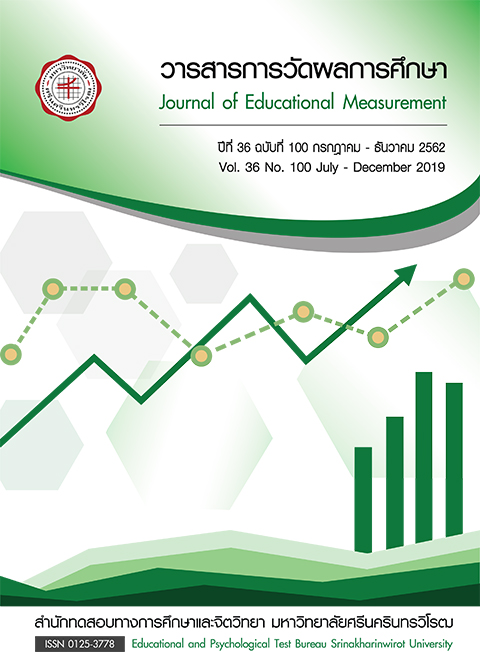A synthesis of instructional research employing SQ4R technique for improving student reading comprehension outcomes: A meta-analysis
Keywords:
meta-analysis, SQ4R technique, reading comprehensionAbstract
The purposes of this research were (1) to analyze the characteristics of instructional research employing SQ4R technique for reading comprehension, (2) to analyze the distribution of effect sizes of instructional research employing SQ4R technique for reading comprehension, and (3) to compare the effect sizes of instructional research employing SQ4R technique for reading comprehension under different research quality groups and different educational stages. The research reports used for synthesis were 12 educational theses employing SQ4R technique for reading comprehension, which published during 2011 – 2017. The data were analyzed with descriptive statistics, t-test, and analysis of variance (one-way ANOVA). The research findings were as follows:
- 1. For meta-analysis, (1) the characteristic of theses in terms of discrete variables found that most of educational theses employing SQ4R technique for reading comprehension were published in 2013 (33.30%). In regard of the field of study, these theses mostly from the field of curriculum and instruction (66.70%), in which most of them were from Mahasarakham University (25.00%) and Rajabhat Maha sarakham University (25.00%). Moreover, all of them were master’s theses (100.00%). (2) The characteristic of theses in terms of substantive found that the majority of research objectives were to develop and explore the quality of innovation (91.70%), in which most of them were employed the one-group pretest- posttest design (75.00%), mostly generated a directional hypothesis (83.30%). With these, mostly conducted in the second educational stage (50.00%). In regard of the instrument, the tests were employed for measuring the independent variables and dependent variables (83.30% and70%, respectively). (3) The characteristic of theses in terms of research methodology found that these theses mostly compared the reading comprehension outcomes between the pretest and posttest (91.70%). Most of them employed a random selection (58.30%), and the majority of them (66.7%) had a significant at .01 level. (4) The characteristic of theses in terms of research quality found that the majority of theses (58.30%) had a good quality.
- 2. Overall, the quality assessment of theses was at a good level (M = 3.15).
- 3. There were 12 values of effect sizes for hypothesis testing. For comparing the effect size of instructional research employing SQ4R technique for reading comprehension, the findings indicated that there was not a statistically significant difference of effect size of instructional research employing SQ4R technique for reading comprehension under research quality groups; good and excellent (t = 4.04, p = .72). Furthermore, it also revealed that there was not a statistically significant difference of effect size of instructional research employing SQ4R technique for reading comprehension among four different educational stages (F = 0.42, p = .75).
References
ไกรษร ประดับเพชร. (2561). การพัฒนาแบบฝึกทักษะร่วมกับเทคนิคการอ่านแบบ SQ4R เพื่อส่งเสริมทักษะการอ่านจับใจของนักเรียนชั้นประถมศึกษาปีที่ 3 โรงเรียนไตรคามประชาสรรค์. สืบค้น 5 กุมภาพันธ์ 2562. จาก http://www.ska2.go.th/reis/data/research/25611231_105007_4812.pdf.
ธิดา บู่สามสาย. (2559). การพัฒนาทักษะการอ่านจับใจความ ด้วยเทคนิคการเรียนรู้แบบ SQ4R โดยใช้ข้อมูลท้องถิ่น จังหวัดกาญจนบุรี ของนักเรียนชั้นประถมศึกษาปีที่ 5. Veridian E-Journal ฉบับภาษาไทย สาขามนุษยศาสตร์ สังคมศาสตร์ และศิลปะ, 9(3), 191-204.
นงลักษณ์ วิรัชชัย. (2542). การวิเคราะห์อภิมาน (meta – analysis). กรุงเทพ: จุฬาลงกรณ์มหาวิทยาลัย.
นงลักษณ์ วิรัชชัย และคณะ. (2552). รายงานการสังเคราะห์งานวิจัยเกี่ยวกับคุณภาพการศึกษาไทย: การวิเคราะห์อภิมาน (Meta – analysis). กรุงเทพ: โรงพิมพ์แห่งจุฬาลงกรณ์มหาวิทยาลัย.
พันธุ์ทิพา หลาบบุญเลิศ. (2535). ภาษาไทย 3. พิมพ์ครั้งที่ 5. กรุงเทพฯ: สำนักพิมพ์จุฬาลงกรณ์วิทยาลัย.
พิรุนเทพ เพชรบุรี. (2559). ผลของการใช้กระบวนการสอนอ่านแบบ SQ4R ร่วมกับเทคนิคอุปมา/เปรียบเทียบ เพื่อส่งเสริมทักษะการอ่านจับใจความของนักเรียนระดับชั้นประถมศึกษาปีที่ 6. กรุงเทพฯ: คณะ ครุศาสตร์ จุฬาลงกรณ์มหาวิทยาลัย.
ภิรดี วัชรสินธุ์. (2544). การวิเคราะห์อภิมานงานวิจัยเฉพาะรายของผลการพัฒนาพฤติกรรมของเด็ก: การวิเคราะห์เปรียบเทียบการประมาณค่าขนาดอิทธิพล 3 วิธี. (วิทยานิพนธ์ปริญญามหาบัณฑิต) กรุงเทพฯ: จุฬาลงกรณ์มหาวิทยาลัย บัณฑิตวิทยาลัย สาขาวิชาวิจัยการศึกษา.
รัศนา จั่นสกุล. (2547). การสังเคราะห์งานวิจัยที่ใช้การวิเคราะห์ข้อมูลด้วยโมเดลเชิงเส้นตรงระดับลดหลั่น: การวิเคราะห์อภิมาน. (วิทยานิพนธ์ปริญญามหาบัณฑิต) กรุงเทพฯ: จุฬาลงกรณ์มหาวิทยาลัย บัณฑิตวิทยาลัย สาขาวิชาวิจัยการศึกษา.
วรรณี อริยะสินสมบูรณ์. (2544). การสังเคราะห์งานวิจัยในสาขาจิตวิทยาการศึกษา: การวิเคราะห์อภิมาน. (วิทยานิพนธ์ปริญญามหาบัณฑิต) กรุงเทพฯ: จุฬาลงกรณ์มหาวิทยาลัย บัณฑิตวิทยาลัย สาขาวิชาวิจัยการศึกษา.
Djudin, T. & Amir, R. (2018). Integrating SQ4R technique with graphic postorganizers in the science learning of earth and space. Jurnal Pendidikan IPA Indonesia, 1, 76 – 84.
Khusniyah, N. L., Rasyid, Y., & Lustyantie, N. (2017). Improving English Reading Comprehension Ability through Survey, Questions, Read, Record, Recite, Review Strategy (SQ4R). English Language Teaching, 10(12), 202–211.
Wong, L. (2009). Essential study skills (6th ed.). Boston: Houghton Mifflin Company.



